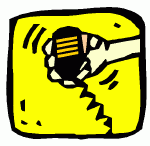 Sometimes radio amateurs suggest that phonetics are not needed on VHF FM. (See examples here and here.) Sometimes it even sounds like it’s a bad thing to use phonetics on FM. It is inefficient and slows things down. I can see the logic behind this because with decent signal strength, demodulated FM audio is usually quite clear and easy to understand.
Sometimes radio amateurs suggest that phonetics are not needed on VHF FM. (See examples here and here.) Sometimes it even sounds like it’s a bad thing to use phonetics on FM. It is inefficient and slows things down. I can see the logic behind this because with decent signal strength, demodulated FM audio is usually quite clear and easy to understand.
Here’s what I wrote in my VHF FM Operating Guide, also downplaying the need for phonetics:
The use of phonetics is not usually required due to the clear audio normally associated with frequency modulation. Still, sometimes it is difficult to tell the difference between similar sounding letters such as “P” and “B”. Under such conditions, use the standard ITU phonetics to maintain clarity. Many nets specifically request the use of standard phonetics to make it easier on the net control station.
The FCC Technician exam gives the topic of phonetics a light touch with just these two questions:
T1A03 (D)
What are the FCC rules regarding the use of a phonetic alphabet for station identification in the Amateur Radio Service?A. It is required when transmitting emergency messages
B. It is prohibited
C. It is required when in contact with foreign stations
D. It is encouraged
And this one:
T2C03 (C)
What should be done when using voice modes to ensure that voice messages containing unusual words are received correctly?A. Send the words by voice and Morse code
B. Speak very loudly into the microphone
C. Spell the words using a standard phonetic alphabet
D. All of these choices are correct
Use Phonetics
In practical radio operating, there are a number of things that can degrade communication, usually by creating noise sources that compete with the voice modulation. Most of these are a factor even if the RF signal is strong:
- A noisy environment at the receiving end (e.g., background noise such as road noise in an automobile)
- A noisy environment at the transmitter (e.g., background noise such as wind noise outdoors)
- Poor frequency response of the overall system (e.g., high frequencies may be lost in the transmitter, receiver or repeater, making it more difficult to understand the voice communication).
- Hearing impairment of the person receiving the audio (I’ve heard that we are all getting older)
- Difficulty understanding the person speaking (poor enunciation, unfamiliar dialect or accent, etc.)
So I say go ahead and use phonetics on VHF FM, especially for critical information such as your call sign. FM communication is not always clear and easy to understand. It suffers from the same signal-to-noise problems as other voice modes. (Perhaps not as bad as SSB on HF, but it’s still a factor.) In most cases, you’ll want to stick with the standard ITU phonetic alphabet (also known as the NATO alphabet).

Many nets request that you use ITU phonetics when you check in. Imagine being the Net Control Station for a net and having everyone making up their own phonetics. You would have call signs coming at you with all kinds of random words associated with them. It is much better to have consistency. However, there are times when you might want to use alternative phonetics. See the HamRadioSchool.com article: Phonetic Alphabets for more insight on that.
73, Bob
Kilo Zero November Romeo
Phonetics on FM? Absolutely appropriate. I’ve used them in telephone conversations, when reading off say part numbers and the like. Very handy. Even in face-to-face conversations phonetics are occasionally useful: “C?” “No, Z.” “Right, C.” “No! Zulu!” “Oh, Zee.”
I’m all in on using phonetics for giving someone your callsign the first time because although FM is clear some people’s voices are not. Also, some letters sound like others when said pretty fast. For example, my call is KU4GW, but a lot of people think I’m saying KE4GW when I say it at my normal talking speed so I always use the phonetics until they get familiar with my call. That way there’s no doubt as to what my callsign is. Very 73!
I use phonics on fm for id. I also call cq on the universal 146520
Phonetics is a great tool—-when needed. As pointed out sometimes it clears confusion. Sometimes it creates the same confusion; when signing off many use it so quickly that I and I am certain others can’t hear fast enough, especially when the HAM sending runs it all together. We may have “dropped in” during the QSO and would like call back but can not be effective because we couldn’t copy. As with all voice communication, slower speech with emphasis on diction is important.